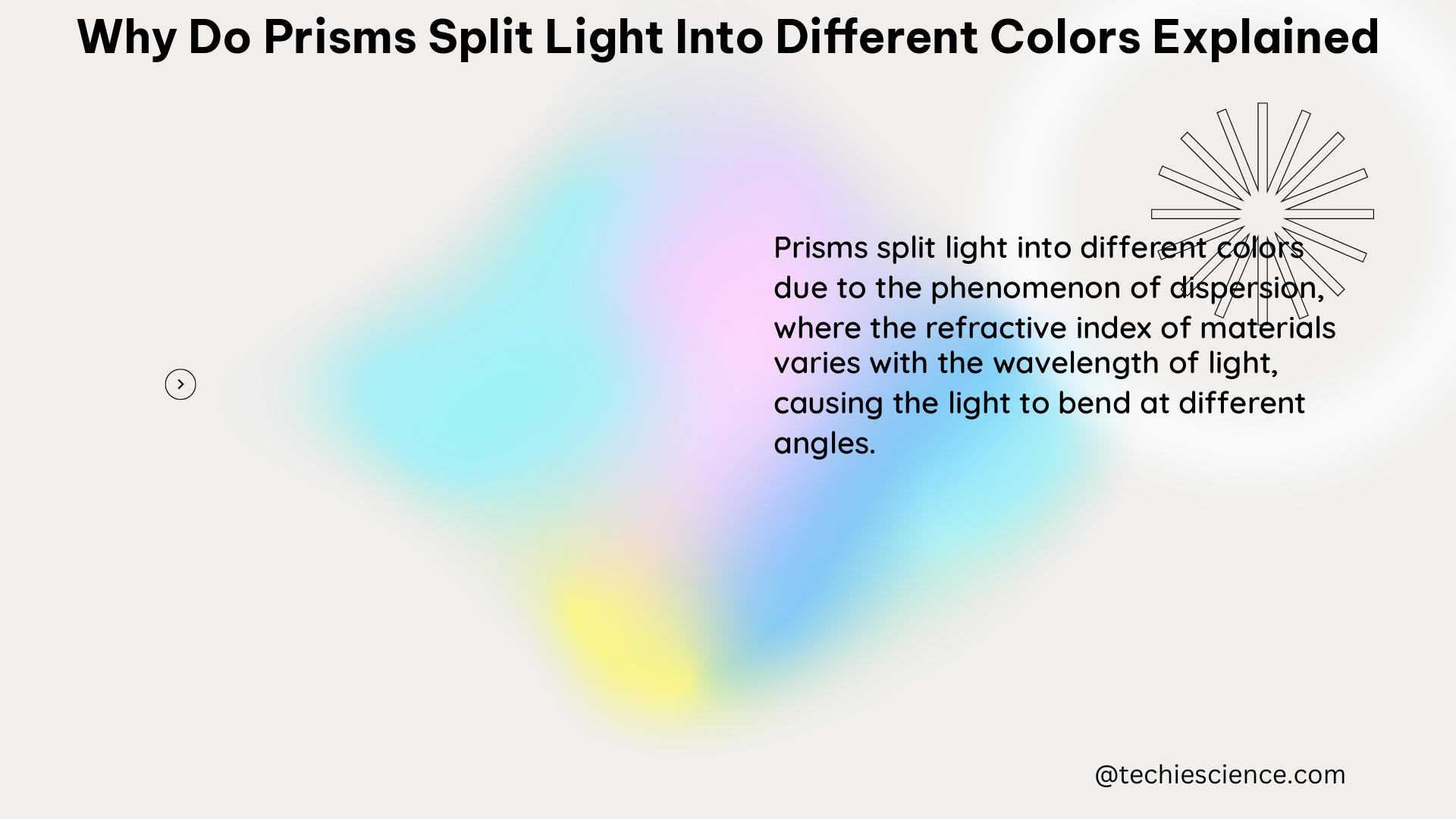Prisms split white light into its constituent colors due to the phenomenon of dispersion, where different wavelengths of light refract by varying amounts as they pass through the prism. This is caused by the different refractive indices of the individual colors within the light spectrum.
Understanding Refractive Indices and Dispersion
-
Refractive Index (n): The refractive index of a medium is a measure of how much the speed of light slows down in that medium compared to a vacuum. The refractive index is a dimensionless quantity, and it varies for different wavelengths of light.
-
The refractive index of a material is given by the formula:
n = c/v, wherecis the speed of light in a vacuum, andvis the speed of light in the medium. -
For example, the refractive index of crown glass (a common material used in prisms) for the yellow-green D line (589.3 nm) is approximately 1.52.
-
Dispersion: Dispersion is the phenomenon where different wavelengths of light refract by different amounts when passing through a medium with a varying refractive index.
-
The refractive index of a material typically decreases as the wavelength of light increases. This means that shorter wavelengths (e.g., violet) have a higher refractive index than longer wavelengths (e.g., red).
- When white light, which is a mixture of all visible wavelengths, passes through a prism, the different wavelengths are refracted by different amounts, causing the light to separate into its constituent colors.
Snell’s Law and Angle of Deviation

- Snell’s Law: Snell’s Law relates the angles of incidence, refraction, and the refractive indices of the two media involved. It is given by the equation:
n1 sin(θ1) = n2 sin(θ2)
where n1 and n2 are the refractive indices of the two media, θ1 is the angle of incidence, and θ2 is the angle of refraction.
-
Angle of Deviation (δ): The angle of deviation is the angle between the incident light ray and the emergent light ray after passing through the prism.
-
The angle of deviation is different for each color of light due to the varying refractive indices.
-
For a prism with a refractive index of
n, the angle of deviationδis given by the formula:δ = (n - 1/n) (α + sin(α))where
αis the apex angle of the prism.
Example Calculations
Let’s consider a prism made of crown glass with a refractive index of 1.52 for the yellow-green D line (589.3 nm). The refractive indices for other colors are:
- Red light (656.3 nm):
n = 1.514 - Blue light (486.1 nm):
n = 1.532 - Violet light (435.8 nm):
n = 1.544
Suppose white light enters the prism at an angle of incidence of 45 degrees. The angle of refraction for the different colors can be calculated using Snell’s Law:
- Red light:
θr = sin^-1(1/1.52 * sin(45°)) ≈ 27.2° - Blue light:
θb = sin^-1(1.532/1.52 * sin(45°)) ≈ 29.1° - Violet light:
θv = sin^-1(1.544/1.52 * sin(45°)) ≈ 30.3°
The resulting angle of deviation for the different colors is:
- Red light:
δr = (1.514 - 1/1.514) (60° + sin(60°)) ≈ 3.8° - Blue light:
δb = (1.532 - 1/1.532) (60° + sin(60°)) ≈ 4.2° - Violet light:
δv = (1.544 - 1/1.544) (60° + sin(60°)) ≈ 4.4°
This difference in the angle of deviation causes the separation of colors as the light exits the prism, resulting in the familiar spectrum of colors.
Critical Angle and Total Internal Reflection
-
Critical Angle: The critical angle is the angle of incidence at which the refracted ray grazes the boundary between the two media, and no refracted ray is formed.
-
The critical angle
θcis given by the formula:θc = sin^-1(n2/n1), wheren1andn2are the refractive indices of the two media. -
For a prism-air interface, the critical angle depends on the refractive index of the prism material.
-
Total Internal Reflection: When light enters a prism at an angle greater than the critical angle, total internal reflection occurs, further contributing to the separation of colors.
-
During total internal reflection, the light ray is reflected back into the prism, and no refracted ray is formed.
- The angle of reflection is equal to the angle of incidence, and the different wavelengths of light are reflected at different angles, enhancing the dispersion effect.
By understanding the concepts of refractive indices, Snell’s Law, angle of deviation, critical angle, and total internal reflection, we can explain the phenomenon of why prisms split light into different colors.
Additional Resources
- Refraction of Light through Prism
- Dispersion of Light by Prisms
- Light and Prism
- Why Does a Prism Split Up Light into Different Colors?
- Prism and Light Refraction

The lambdageeks.com Core SME Team is a group of experienced subject matter experts from diverse scientific and technical fields including Physics, Chemistry, Technology,Electronics & Electrical Engineering, Automotive, Mechanical Engineering. Our team collaborates to create high-quality, well-researched articles on a wide range of science and technology topics for the lambdageeks.com website.
All Our Senior SME are having more than 7 Years of experience in the respective fields . They are either Working Industry Professionals or assocaited With different Universities. Refer Our Authors Page to get to know About our Core SMEs.